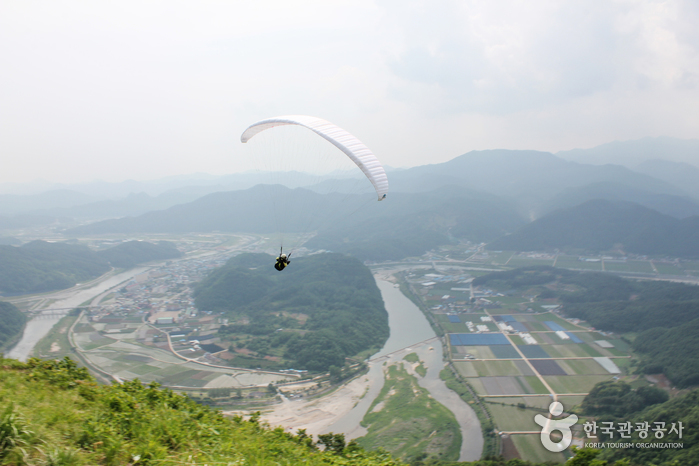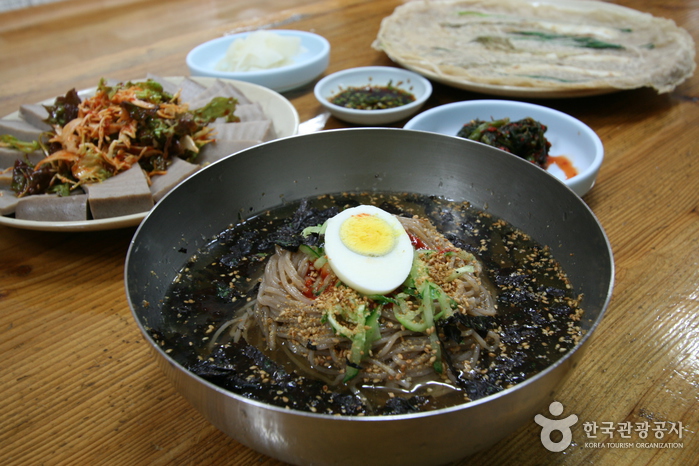Lee Hyo-seok Culture Village (이효석문화마을)
17.9Km 2022-12-29
Wongil-ri, Pyeongchang-gun, Gangwon-do
+82-33-335-9669
Lee Hyo-seok Culture Village is the place where the author Lee Hyo-seok (pen name “Gasan”) was born and raised. The village is also the setting of the author’s novel "When the Buckwheat Blossoms,” one of the most celebrated Korean short stories to date.
In 1990, the village place was designated ‘first national cultural village’ by the Ministry of Culture and Tourism. The village is comprised of the author's birth house, a water mill, Gasan Park, Lee Hyo-seok Memorial Hall, and a buckwheat museum. During the peak of the blossoming season in early fall, the annual Lee Hyo-seok Cultural Festival takes place and visitors can enjoy the beautiful scenery of snow-white fields of buckwheat flowers.
Lee Hyo-seok Cultural Festival commemorates the modern Korean writer and features buckwheat-themed programs. Events include a Hyo-seok essay contest, traditional performances, a costume parade, a photo contest, and "When the Buckwheat Blossoms" plays and related performances. During the festival, visitors can enjoy makguksu (buckwheat noodles) and memil buchim (buckwheat pancakes) and tour the locations that appear in the famous short story.
Heungjeonggyegok Valley (흥정계곡)
18.0Km 2024-02-13
62 Heungjeonggyegok-gil, Bongpyeong-myeon, Pyeongchang-gun, Gangwon-do
+82-33-330-2771
Heungjeonggyegok Valley is about 5 kilometers away from the town of Bongpyeong-myeon in Pyeongchang, Gangwon State. The 5-kilometer long valley that stands between Heungjeongsan Mountain and Hoeryeongbong Peak has a beautiful landscape. A wide variety of freshwater fish like trout inhabit the clear waters of the valley. Heungjonggyegok Valley has become a famous attraction in the Bongpyeong area along with Bongsan Seojae, shrine of the prominent neo-Confucian scholar Yulgok (1536-1584), and Palseokjeong, featuring the writings of Yang Sa-eon.
Hyoseok Cultural Festival (평창효석문화제)
18.0Km 2025-07-10
157 Ihyoseok-gil, Pyeongchang-gun, Gangwon-do
+82-33-335-2323
Korean novelist Lee Hyo-seok is from Pyeongchang, Gangwon State, and is known for his novels that combine stories with the beauty of nature. The Pyeongchang Hyoseok Cultural Festival, held every autumn in Bongpyeong, the setting of his famous work “When the Buckwheat Flowers Bloom,” celebrates his legacy and showcases the region’s beauty. The festival runs a variety of literary programs, such as an essay contest, a poetry event, and bookmaking. In the evening, there are small-scale literary and music performances to add to the romantic charm of the festivities. During the festival, the fields near the village are filled with white buckwheat flowers, creating a spectacular view as though they were waves of white snow rippling in the wind. A key highlight of the festival is capturing memorable photos against the backdrop of the buckwheat fields, which are the most cherished mementos of the event.
◎ The short novel “When the Buckwheat Flowers Bloom,” published in 1936, is a beloved work that captures themes of love and humor set against a buckwheat field. In September, Bongpyeong reaches the peak of its beauty with fields of white buckwheat flowers in full bloom.
Hyoseok Culture Village Buckwheat Food Street (효석문화마을 메밀음식거리)
18.3Km 2021-03-11
31, Gipung 3-gil, Pyeongchang-gun, Gangwon-do
+82-33-330-2771
The Hyoseok Culture Village is the place where author Lee Hyo-seok (penname “Gasan”) was born and raised. The village is also the setting of the author’s story "When Buckwheat Flowers Bloom,” one of the most celebrated Korean short stories to date. Since 1999, the Hyoseok Cultural Festival has been held here every September to commemorate the writer. Visitors to the festival can enjoy various foods and events as well as a replica of scenes from the book. For those that are searching for a more tranquil visit, avoid the month of September, when the buckwheat flowers are in full bloom. Don't forget to try all the different memil (buckwheat) dishes offered throughout the area all year round.
Jangamsan Paragliding Field (장암산 활공장)
18.3Km 2022-06-27
129, Jangamdong-gil, Pyeongchang-gun, Gangwon-do
+82-33-332-2625
Paragliding is controlled by the power of body weight. Hang gliding and paragliding are both included in manpowered gliders, which refers to gliders weighing less than 50 kilograms in dead weight. Paragliding has the shortest history among air sports, but is the most popular manpower glider.
Anyone can enjoy paragliding and after a 3 to 4-hour training course, participants can take off from a 50 meter steep hill. The total weight of the glide is just 10 kilograms, light enough to carry on one’s back, and carries very little danger if riders follow proper precautions.
Jangamsan Paragliding Field is located near Pyeongchang and the mountain is mainly comprised of stones, making it possible for people to enjoy a real thermal flight experience. The field is suitable for families who wish to enjoy camping with paragliding. The landing field is situated along the Pyeongchanggang River, which is also available for swimming after the flight. The river has a spacious pool on both upstream and downstream, making it a perfect venue for safety clinic education as well.
Hyundai Buckwheat Noodles (현대막국수)
18.3Km 2025-10-23
17 Dongijangteo-gil, Bongpyeong-myeon, Pyeongchang-gun, Gangwon-do
Buckwheat, a staple in Gangwon State, is finely milled to make the base for Buckwheat Noodles. In Pyeongchang, where buckwheat fields are a common sight, numerous eateries specialize in these noodles. The signature dish here is the Pure Buckwheat Noodles, made exclusively from Korean-grown buckwheat. Its popularity stems from the noodles’ light broth, garnished with vegetables, offering a clean, non-overpowering flavor. For those who prefer a bit of a kick, the Spicy Buckwheat Noodles come with a tangy seasoning, customizable to taste. The accompanying side dishes are equally delightful, featuring items like Buckwheat Pancakes with buckwheat and cabbage, and Buckwheat Crepes stuffed with kimchi filling—each menu item invites one to savor the authentic essence of this cherished grain.
Herbnara Farm (허브나라농원)
18.7Km 2024-08-06
225 Heungjeonggyegok-gil, Pyeongchang-gun, Gangwon-do
+82-33-335-2902
Herbnara Farm opened in 1996 as the first herb-themed farm in Korea. The farm was started in a deep valley in Pyeongchang by a couple whose age added up to 100 years. At that time, the farm was just a small plot of land, but has expanded to the current 33,000 ㎡ and is one of Pyeongchang's representative tourist attractions. The farm offers ten themed gardens with over 150 herbs such as lavender and sage. Delicious dishes and drinks made with herbs cultivated on the farm are available at the restaurant and cafe. Visitors can also make herbal soap and candles in the herb classroom, and enjoy cultural events throughout the farm.
Chiaksan National Park (치악산국립공원)
19.4Km 2025-03-15
26, Musoijeom 2-gil, Wonju-si, Gangwon-do
+82-33-740-9900
Chiaksan Mountain has several peaks reaching x_heights of over 1,000 meters, including Namdaebong, Cheonjibong, Hyangnobong, Sambong, and Birobong Peak, the tallest of the peaks at 1,288 meters. Chiaksan National Park, designated in 1984, encompasses a 182.09 ㎢ area with a 14-kilometer trail connecting the peaks from Birobong Peak in the north to Namdaebong Peak in the south.
In addition to these soaring peaks, the park also includes many deep valleys, unique rock formations, waterfalls, and tourist attractions. Some of the more popular destinations are Geumdaegyegok Valley, Taejongdae Rock, Seryeompokpo Falls, and Guryongsa Temple. The park draws in hikers all year round, with bright azaleas in spring, lush forests in summer, vibrant foliage in fall, and a white wonderland in winter.






 English
English
 한국어
한국어 日本語
日本語 中文(简体)
中文(简体) Deutsch
Deutsch Français
Français Español
Español Русский
Русский